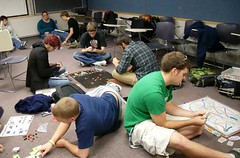Reading the Chronicle of Higher Education on 8/10/2010 I was reminded that, as a new semester looms, tension is building for many who will be meeting a new group of students for the first time. Perhaps you find yourself among those feeling the effects of the rapidly approaching semester? During consultations and other interactions with Notre Dame faculty members the topic of first impressions and the first day of class often arises. Given that first impressions are so important we recommend that you give thoughtful consideration to what you will do in that critical first class, while remembering that you are likely to have a number of new students at the second class meeting.
 |
We suggest that you start off with a compelling activity that focuses on a course topic and gives the students a sense of the kind of work they will do during the semester. You can then present your syllabus and discuss policies at the end of the first class or distribute the syllabus at the end of the first class, ask students to review the it, and discuss and highlight critical information and policies at the start of the second class.
This strategy has two distinct advantages. First, the students’ first impression will be that during class time they will engage with concepts and ideas critical to the work they will do during the semester. This will help the students better understand your expectations and give them a substantive basis to make a decision if they are not certain that they will stay in the class. It also avoids starting with the potentially less stimulating experience of reviewing the syllabus and course policies, a traditional opening for many courses. The second advantage is that if you wait until the second day to highlight critical information and policies from the syllabus, it will be more likely that all of the students who will remain in the class for the semester will be present. I confess that for years I began my classes with a review of the syllabus and course policies, often spending 30-40 minutes on these items. If a new student arrived on the second day of class I handed them the syllabus and told them to let me know if they had any questions. In retrospect, I believe I did a disservice to those students that added my course after the first day.
How might you start your class in a way that engages students in a meaningful way with important concepts?
For more ideas about preparing for the approaching semester see the Chronicle of Higher Education ProfHacker article “From the Archives: Preparing for the First Week of Classes” or contact the Kaneb Center at kaneb@nd.edu or 631-9146 to arrange a consultation.
